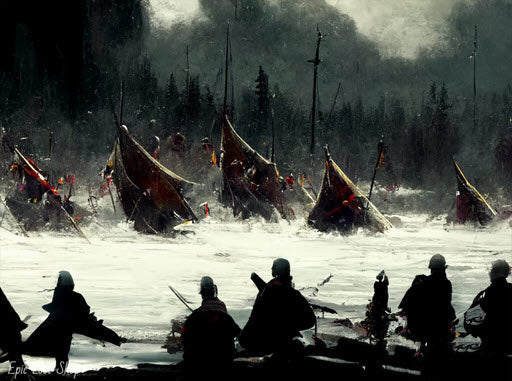Did The Vikings Ever Actually Exist?
When speaking of the Vikings, we tend to speak of them as if they were a people and a culture that existed in one place at one time. But there is no single Viking history. The Vikings were actually a loose confederacy of tribes that lived in Scandinavia (modern-day Denmark, Norway, and Sweden) between about A.D. 800 and the 11th century. They shared many beliefs, customs, and traditions, but their social systems were different from tribe to tribe over time. And many of the details that have come down to us about their culture—their spectacular achievements in shipbuilding and exploration, for example—are based on myths more than facts.
What did Vikings actually look like?
Vikings have a special place in our collective imagination, but what we think of as the typical Viking doesn’t actually match up with the historical record. Vikings were often portrayed as tall and blond in movies and TV shows like The Vikings and Vikings, but that image is more a result of Nordic-centrism than anything else. In fact, the people who lived in Scandinavia during the Viking Age were primarily red-headed, with some blue and green eyes.
A lot has changed since then! Today, Scandinavians are more likely to be blonde or brown-haired, with blue eyes.
A new study published in Science Advances by Swedish researchers analyzed mitochondrial DNA from 69 ancient skeletons from Scandinavia (28 men and 41 women) and found that over 90% of them had red hair, which is much higher than today’s population (in 2012, 2.4% of Swedes had red hair). The researchers also studied skulls, which they scanned with computed tomography to get accurate eye color measurements. They found that most of them (60%) had blue or green eyes, while the rest had brown or black eyes.
How tall was the average Viking?
It's hard not to imagine the Vikings as towering, fierce warriors when you think about them. After all, they were tall enough to stand out in a crowd of their contemporaries. But just how tall were Viking men?
A recent study analyzed the skeletal remains of Viking men, women, and children and compared them to those of other ancient European populations. The researchers found that the average height for Viking men was 173.6 cm (5 ft 8.5 in) while that of women was 152.7 cm (5 ft) tall. This is a little bit shorter than modern-day Scandinavians, who are generally taller than the rest of Europe due to a genetic quirk that stems from the Viking era, but it's still significantly taller than people from other regions during the same time period.
What country has the most Viking DNA?
A study done in 2009 by the Stockholm International Peace Research Institute (SIPRI) found that Norway had the highest percentage of DNA that could be traced back to Scandinavia's first inhabitants. They looked at mitochondrial DNA (mtDNA), which is passed on through children and comes from their mother. This means that, if you have mostly Scandinavian mtDNA, your mother must be descended from Vikings—or at least, she must have inherited some of their DNA. Apparently about 25% of Norwegians share this kind of ancestry. Scandinavian countries' general proximity to Scandinavia and the fact that their borders are still relatively porous make them good candidates for higher percentages of Viking DNA. The percentages drop off sharply in farther-flung countries like Iceland and Denmark, whose residents tend to have more diverse genetic histories thanks to their larger populations and geographical isolation.
What language did Vikings speak?
The Vikings were a seafaring people, and their language evolved in place to become what we now know as Old Norse. Old Norse is a Germanic language, which means that it belongs to the same language family as English, German and Icelandic (and hundreds of other modern languages).
In many ways, Old Norse is like English—it has nouns, adjectives, verbs and adverbs. It has prepositions and articles. It has distinct but related dialects. And it has its own unique history, quirky spellings and pronunciations.
Was there black Vikings?
One of the most surprising things about Viking culture is the presence of black people within it. The Vikings traveled across much of Europe and beyond, from Iceland to Greenland to North America, and there's plenty of historical evidence that many Vikings had black or brown skin—like the 9th-century Arab traveler Ahmad Ibn Fadlan, who wrote about a Viking he met with "a huge, black man… His face was so dark that darkness itself seemed to radiate from his face."
Though it's not often depicted in modern retellings, black Vikings have been present in historical documents going as far back as the 10th century. They were mentioned in the Icelandic sagas (Sturlunga saga), which were written down in the 13th century but based on much earlier oral tradition, with one passage referring to an African slave as "the Ethiopian" who went on to become a famous Viking leader. In addition to Ibn Fadlan's account from centuries earlier, there was also a group of 10th-century Muslim slaves who escaped their captors and were taken in by a Viking chieftain named Thorir Hund. These slaves traveled extensively with Thorir Hund and his men, serving them as bodyguards, servants, and even soldiers.
Was there a black Viking Queen?
According to the Icelandic sagas, one Viking queen was so dark-skinned that she was called Heljarskinn, “Black-Skin.” Her name was Ljufvina, and she is said to have been a princess of Mongolian descent who married the legendary Viking King Hjor.
Ljufvina and Hjor reigned as king and queen of the Norsemen at Karmsundet (present-day Larvik), where they had two sons: Hamund and Geirmund. They were nicknamed Heljarskinn (Black-Skin) because of their dark skin color.
Ljufvina was born to a family of nomads from the east (possibly from the Mongolian steppe). Her father had his people follow the whales and fish around Scandinavia, and she was likely born just outside of Norway. Early on in her life, she was captured by a raiding party of Norsemen. She was taken and presented as a gift to Hjor, who she eventually married.
Ljufvina’s skin was darker than that of other women in Scandinavia; it is believed that this could have been due to her nomadic heritage. Regardless, Hjor was not bothered by this fact. In fact, he loved his wife very much and perhaps appreciated her exotic look and features in contrast with the more European countenance of most Norsemen.
Did Vikings do slavery?
It's easy to imagine the Vikings as a barbaric force, but it's important to remember that they were just as much a part of their time as we are of ours. As much as slavery is a part of our history, so was the buying and selling of captives. The Vikings took slaves on raids and traded in them among themselves, but they also had slaves given to them as gifts, or even inherited after their owners died. Many of these slaves were people taken in raids, but plenty weren't: some were criminals who'd been sentenced to slavery, others were people who couldn't pay their debts and served their creditors as payment. The Viking system was complicated and allowed for plenty of exceptions and variations in what amounted to slavery—but it's undeniable that the practice was an accepted one.
How did Vikings get so strong?
Viking warriors were some of the toughest in all of history. In order to be a Viking warrior, you had to be able to handle yourself in battle.
In order to survive, you had to know how to fight—and that meant knowing how to fight with your bare hands, how to use an axe or sword, how to use a bow and arrow, and even how to use a spear while riding on horseback. And that was just the beginning.
As military training was part of everyday life for Viking men, they were constantly honing their fighting skills—which could serve them well when it came time for the Vikings' favorite pastime: raiding villages abroad. In fact, these attacks were so common that almost every male who lived in Scandinavia was required by law to know how to defend his village during a surprise attack.
What good things did the Vikings do?
You might be surprised to learn that many of the things we tend to think of as part of a quintessentially "Viking" lifestyle were, in fact, achievements unique to the Vikings. Sure, they wore horned helmets and fought with swords in addition to their own massive ships, but the Vikings had little in common with the barbaric stereotypes they've since come to represent.
They were actually advanced, literate people who adapted to their environment and succeeded because of it. They became such successful traders thanks to their new shipbuilding technology, which allowed them to travel greater distances than anyone before them. Additionally, most Viking houses featured indoor plumbing. Their legal system was so advanced that other European countries would often use theirs as a model for their own systems. The Vikings were also skilled farmers and fishermen—you won't find any stories about them pillaging local farms or fishing villages and taking what they needed. They helped these rural communities thrive by providing a market for excess goods. So if you're tempted to think of Vikings as purely destructive or brutal warriors, remember these important details about them too!
What ended the Viking Age?
The Viking Age lasted from 793 CE to 1050 CE, but it's the end date that's the most contested. Some historians believe that the Viking Age ended in 1050 with the death of Harald Hardrada and the Norman conquest of England, while others say it ended a century earlier, coinciding with the Battle of Hastings and the Norman conquest of England. Most scholars agree that after 1050, Vikings were no longer a major force in Europe—but just why they stopped being such a force is still up for debate. There are lots of theories. Some people say that the Vikings lost their raiding edge and just couldn't adapt to new military tactics and technology. Others say that the Vikings eventually just ran out of people to raid.
Conclusion
While many of us are familiar with the Vikings' achievements, myths, and legendary raiding parties, most people don't actually know a lot about them. Who were they? Where did they come from? What did they look like? These are all questions that can't be answered definitively by looking at historical documents. In general, a positive picture of the Vikings is indeed accurate. They were not bloodthirsty barbarians—although they were certainly capable of fearsome acts, as any group (or individual) is when angry or threatened. they were warrior-farmers who lived on the edge of poverty, and they turned to raiding when times were tough. The Viking Age itself lasted just two centuries, roughly from the late 8th to the mid-11th century. And while it was a period of significant change in Scandinavia, most historians don't see it as significantly more bloodthirsty or violent than other eras. In other words, don't believe everything you read—and get the facts before writing off your next trip to Scandinavia!




Leave a comment